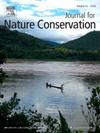Roadkill on medium-sized mammals in a tropical region in southern Mexico
IF 2.5
3区 环境科学与生态学
Q2 BIODIVERSITY CONSERVATION
引用次数: 0
Abstract
Roads are an important driver of economic development. However, roads also produce negative impacts on humans and wildlife as noise contamination, pollution, habitat loss and fragmentation and mortality due to collisions. It has been observed that roadkill threatens populations of mammals, thus the importance for mitigating actions. Here, we documented roadkill of medium-sized mammals on a 114 km of highway located in southern Mexico. A total of 41 roadkill events were recorded of which the northern anteater Tamandua mexicana, the Mexican porcupine Coendou mexicanus, and the common hog-nosed skunk Conepatus leuconotus showed the highest frequency. The northern anteater is regionally considered at risk, and the other two species as threatened. It was estimated that approximately 36.2 medium-sized mammals are road killed annually, with the northern anteater ranking highest with a third of the total. Most of the collisions occurred at sites with less than 20 % tree cover and less than 350 m from water bodies; half occurred less than 500 m from the nearest highway curve. At the local scale, distance to water bodies and closeness to human settlements were significantly related to road collisions. At the landscape scale, the presence of water bodies was related to roadkill. This highway is acting as a sink for medium-sized mammal populations, particularly for the northern anteater. We propose to establish preventive actions such as reducing speed limits, putting speed bumps, driving fences, ropes, signs in strategic places, and police surveillance. We also propose a program to convince local inhabitants and drivers using this road of the importance of preventing roadkill of wildlife.
墨西哥南部热带地区的中型哺乳动物被公路撞死
道路是经济发展的重要动力。然而,道路也对人类和野生动物产生负面影响,如噪音污染、污染、栖息地丧失和破碎化以及碰撞造成的死亡。据观察,被公路撞死的动物对哺乳动物种群构成了威胁,因此采取缓解措施是很重要的。在这里,我们记录了位于墨西哥南部114公里高速公路上的中型哺乳动物被公路撞死的情况。共记录了41起道路死亡事件,其中北部食蚁兽Tamandua mexicana、墨西哥豪猪Coendou mexicanus和普通猪鼻臭鼬Conepatus leuconotus的发生频率最高。北部食蚁兽在当地被认为处于危险之中,另外两个物种受到威胁。据估计,每年大约有36.2只中型哺乳动物被道路杀死,其中北方食蚁兽的数量最多,占总数的三分之一。大多数碰撞发生在树木覆盖率低于20%和距离水体小于350米的地点;其中一半发生在距离最近的公路弯道不到500米的地方。在局地尺度上,距离水体的距离和距离人类住区的距离与道路碰撞显著相关。在景观尺度上,水体的存在与道路死亡有关。这条高速公路是中型哺乳动物的聚集地,尤其是北方食蚁兽。我们建议建立预防措施,如降低速度限制,设置减速带,在战略地点设置围栏,绳索,标志,以及警察监视。我们还提出了一项计划,让当地居民和使用这条道路的司机认识到防止道路上野生动物死亡的重要性。
本文章由计算机程序翻译,如有差异,请以英文原文为准。
求助全文
约1分钟内获得全文
求助全文
来源期刊

Journal for Nature Conservation
环境科学-生态学
CiteScore
3.70
自引率
5.00%
发文量
151
审稿时长
7.9 weeks
期刊介绍:
The Journal for Nature Conservation addresses concepts, methods and techniques for nature conservation. This international and interdisciplinary journal encourages collaboration between scientists and practitioners, including the integration of biodiversity issues with social and economic concepts. Therefore, conceptual, technical and methodological papers, as well as reviews, research papers, and short communications are welcomed from a wide range of disciplines, including theoretical ecology, landscape ecology, restoration ecology, ecological modelling, and others, provided that there is a clear connection and immediate relevance to nature conservation.
Manuscripts without any immediate conservation context, such as inventories, distribution modelling, genetic studies, animal behaviour, plant physiology, will not be considered for this journal; though such data may be useful for conservationists and managers in the future, this is outside of the current scope of the journal.
 求助内容:
求助内容: 应助结果提醒方式:
应助结果提醒方式:


